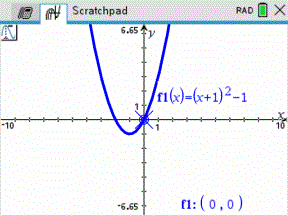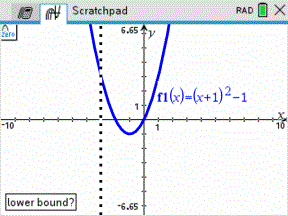| 1. | Press » to open the Scratchpad Graph page if it is not already open. |
By default, the entry line is displayed. The entry line displays the required format for typing a relation. The default graph type is Function, so the form f1(x)= is displayed.
If the entry line is not shown, press Ctrl + G or press b 2 3 to display the entry line and type an expression to graph.
| 2. | Press b > Graph Entry/Edit and select a graph type. |
For example:
| • | To graph an equation for a circle, press b > Graph Entry/Edit > Equation > Circle > (x-h)2 + (y-k)2 = r2 or press b 3 2 3 1. Fill in the equation and press · to draw the circle. |
| • | To graph a function, press b > Graph Entry/Edit > Function or press b 3 1. |
The entry line changes to display the expression format for the specified graph type. You can specify multiple relations of each graph type.
| 3. | Type an expression and any other parameters required for the graph type. |

| 4. | Press · to graph the relation, or press ¤ to add another relation. If necessary, you can use press b 4 to choose a tool on the Window/Zoom menu and adjust the viewing area. |
When you graph the relation, the entry line disappears to show an uncluttered view of the graph. If you select or trace a plot, the relation that defines the plot is displayed on the entry line. You can modify a plot by defining a relation or by selecting and changing the graph.
As you graph multiple plots, the defining relation is displayed for each. You can define and graph a maximum of 99 relations of each type.
| 5. | Use the b key to explore and analyse the relation to: |
| • | Trace the relation. |
| • | Find points of interest. |
| • | Assign a variable in the expression to a slider. |
Viewing the Table
| ▶ | To display a table of values corresponding to the current plots, press b > Table > Split-screen Table (b 7 1). |

| ▶ | To hide the table, click the graph side of the split screen, and then press b > Table > Remove Table (b 7 2). You can also press Ctrl + T. |
| ▶ | To resize columns, click the table and press b > Actions > Resize (b 1 1). |
| ▶ | To delete a column, edit an expression, or edit table settings, click the table and press b > Table (b 2). |
Changing the Appearance of the Axes
As you work with graphs, the Cartesian axes are displayed by default. You can change the appearance of the axes in the following ways:
| 1. | Press b 4 and choose the Zoom tool to use. |
| 2. | Select the axes and press / b 2 to activate the Attributes tool. |
| a) | Press £ or ¤ to move to the attribute to change. For example, choose the end style attribute. |
| b) | Press ¡ or ¢ to choose the style to apply. |
| c) | Change any other attributes of the axes as required for your work, then press · to exit the attributes tool. |
| 3. | Adjust the axes scale and tick mark spacing manually. |
| a) | Click and hold one tick mark, then move it on the axis. The spacing and number of tick marks increases (or decreases) on both axes. |
| b) | To adjust the scale and tick mark spacing on a single axis, press and hold g and then grab and drag a tick mark on that axis. |
| 4. | Change axis end values by double-clicking them and typing new values. |
| 5. | Adjust the location of the axes. To move the existing axes without resizing or rescaling them, click in and drag an empty region of the screen until the axes are in the desired location. |
| 6. | Change the axes’ scales by pressing b > Window/Zoom > Window Settings (b 4 1). |
Type the values of your choice over the current values for x-min, x-max, y-min, y-max, Xscale and Yscale and click OK.
| 7. | Press b > View > Hide Axes (b 2 1) to hide or show the axes. |
| • | If the axes are shown on the page, selecting this tool hides them. |
| • | If the axes are hidden on the page, selecting this tool redisplays them. |
Tracing a Plot
Graph Trace moves through the points of a graphed function, parametric, polar, sequence or scatter plot. To enable the trace tool:
| 1. | Press b > Trace > Graph Trace (b 5 1) to move across the plot in Trace mode. |

| 2. | (Optional) To change the trace step increment for tracing, press b 5 3. |
After you type a different step increment, the Graph Trace tool moves across the graph in steps of that size.
| 3. | Use Graph Trace to explore a plot in the following ways: |
| • | Move to a point and hover to move the trace cursor to that point. |
| • | Press ¡ or ¢ to move from point to point on the function’s graph. The coordinates of each point traced are displayed. |
| • | Press £ or ¤ to move from one plot to another. The point’s coordinates update to reflect the new location of the trace. The trace cursor is positioned on the point of the new graph or plot with the closest x value to the last point identified on the previously traced function or graph. |
| • | Type a number and press · to move the trace cursor to the point on the plot with independent coordinates nearest the typed value. |
| • | Create a persistent point that remains on the graph by pressing · when the trace point reaches the point you want to label. The point remains after you exit Graph Trace mode. |
Notes:
| • | The string undef is displayed instead of a value when you move over a point that is not defined for the function (a discontinuity). |
| • | When you trace beyond the initially visible graph, the screen pans to show the area being traced. |
| 4. | Press d or choose another tool to exit Graph Trace. |
Finding Points of Interest
You can use the tools on the Analyse Graph menu to find a point of interest in a specified range of any graphed function. Choose a tool to find zero, the minimum or maximum, the point of intersection or inflection or the numeric derivative (dy/dx) or Integral on the graph.
| 1. | Select the point of interest that you want to find on the Analyse Graph menu. For example, to find a zero, press b 6 1. |
| non-CAS and Exact Arithmetic |
CAS | |
|---|---|---|
|
Zero |
b 6 1 |
b 6 1 |
|
Minimum |
b 6 2 |
b 6 2 |
|
Maximum |
b 6 3 |
b 6 3 |
|
Intersection |
b 6 4 |
b 6 4 |
|
Inflection |
Not applicable |
b 6 5 |
|
dy/dx |
b 6 5 |
b 6 6 |
|
Integral |
b 6 6 |
b 6 7 |
|
Analyse Conics |
b 6 7 |
b 6 8 |
The icon for the selected tool is displayed at the top left on the work area. Point to the icon to view a tooltip about how to use the selected tool.
| 2. | Click the graph you want to search for the point of interest, then click a second time to indicate where to start the search for the point. |
The second click marks the lower bound of the search region and a dotted line is displayed.
Note: If you are finding the derivative (dy/dx), click the graph at the point (numeric value) to use for finding the derivative.
| 3. | Press ¡ or ¢ to move the dotted line that marks the search region, and then click the point at which you want to stop the search (upper bound of the search region). |

| 4. | Press · at the point to start the search. The tool shades the range. |
If the search region you specified includes the point of interest, a label for the point is displayed. If you change a graph that has points of interest identified, be sure to check for changes in points of interest. For example, if you edit the function on the entry line or manipulate a plot, the point where the graph intersects zero can change.
The labelled points of interest remain visible on the graph. You can exit the tool by pressing d or choosing another tool.